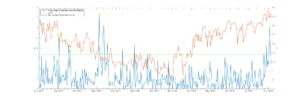by Joana Kollert, Manuel Kreutle, and Michael Brüggemann
Recent weeks have not only brought about record-breaking temperatures, but also a rise in climate coverage, as clearly shown by our Online Media Monitor (OMM) on Climate Change Coverage around the world [1]. But are higher-than-usual temperatures really the main trigger of climate change reporting? We had a closer look at the case of Germany: climate change has recently spread from science sections onto front pages. Not only the leading intellectual weekly Die Zeit printed it on the first page; climate scientists also made headlines in the tabloid BILD, and the popular evening TV Show Anne Will raised the question of how we should act in the face of climate change. Going beyond these anecdotal observations of the last few weeks, we examined the correlation of maximum temperatures and climate change media coverage in Germany between the 2nd of August 2017 and the 6th of August 2018.
The weather data stems from different weather stations in Germany, operated by the Deutscher Wetterdienst [2]. For every day, the data from the station that measured the highest temperature was chosen. The temperature data were compared with the daily share of climate-relevant articles in three major German news outlets (Süddeutsche Zeitung, Spiegel Online, Tagesschau.de) [3]. Figure 1 shows the percentage of climate change coverage in blue and the maximum temperature in red.
The percentage of climate-relevant articles between August 2017 and August 2018 ranged from 0% on several dates to 7.4% on November 5th, 2017, with a mean of about 1.13%.
First of all, this emphasizes that even in these leading news outlets, attention for one of the biggest challenges of our time is fairly limited. Secondly, the maximum in climate-change reporting was recorded in the winter – extreme summer heat, apparently, is not the most powerful driver of coverage. Thirdly, thresholds may play a role: while journalists seem to have enjoyed the warm spring and early summer and the absence of rain without intensifying their coverage of climate change, after weeks with temperatures frequently exceeding 30 degrees, [4] the issue of a problematic drought and heat wave could no longer be ignored.
The heat: we examined the dates on which climate change-relevant articles exceeded 3.39% (twice the standard deviation). On these dates, the correlation between maximum daily temperatures and media coverage is considered to be statistically significant, i.e. linked to genuine effects or associations rather than random error or measurements in variation. Therefore, temperatures do play a role as triggers of coverage. But there are also other triggers.
Other extreme weather events: the first date of interest is the 02.09.2017, with 5.1% of the total articles published on this date related to climate change. This date marks the occurrence of Hurricane Harvey and associated strong rainfalls. Hurricane Harvey likely triggered climate change reporting because climate models indicate that the general frequency and the rainfall rates of such events will possibly increase in the future [5]. A similar but more protracted reaction can be observed on the 17th (4.4%) and 19th September 2017 (3.9%), shortly after the formation of Hurricane Maria.
Politics: on the 4th of November 2017, 5.2% of the total articles published were climate change-related. This was linked to the preparations of the United Nations climate conference COP23 and anti-coal protests in Bonn. Climate change reporting remained high (4.5-7.4%) until the 18th of November 2017, encompassing reports about COP23 and general climate change coverage triggered by the international event. The One-Planet-Climate-Summit in Paris on December 12th 2017 caused a 3.9% climate change media coverage. UN Secretary General Guterres’ speech on December 31st 2017, issuing a ‘red alter’ for planet Earth while mentioning climate change as a major threat, caused another reporting peak of 4.5%.
And again, the heat: on July 25th 2018, wildfires in Greece killed dozens of people, and resulted in 3.5% climate-change relevant articles. In Germany, temperatures already frequently exceeded 30°C at the beginning of June – considerably higher than the average June temperature of 15.7°C recorded between 1901 and 2015 [6]. At the end of July, Germany experienced temperatures over 34°C (see green line in Figure 1). This lengthy heat wave led to a sustained period of more frequent climate-relevant media coverage, with peaks on 29.07.2018 (4.3%) and 03.08.2018 (6%), and over-average media coverage in between these dates.
We can therefore infer that extreme temperatures and other weather events that are becoming more likely in times of climate change do trigger coverage, but political events like the UN climate summits still raise more short-term attention. Even with the current drought and heat wave, the problem of weather events is that their duration exceeds the attention span of media coverage, which is addicted to short-term events.
Yet, journalists are not like frogs sitting in the pot that gradually heats until it boils. At some point, they started writing about climate change – let us hope that attention for this problem is sustained even after it is has cooled down.
References:
[1]: https://icdc.cen.uni-hamburg.de/omm/EU.html
[2]: Free climate station data for Germany, Deutscher Wetterdienst; https://www.dwd.de/DE/leistungen/klimadatendeutschland/klimadatendeutschland.html
[3]: https://icdc.cen.uni-hamburg.de/omm/EU.html
[4]: Free climate station data for Germany, Deutscher Wetterdienst; https://www.dwd.de/DE/leistungen/klimadatendeutschland/klimadatendeutschland.html
[5]: Christensen et al.; “Climate Phenomena and their Relevance for Future Regional Climate Change” (IPCC AR5 Chapter 14); Climate Change 2013: The Physical Science Basis. Contribution of Working Group I to the Fifth Assessment Report of the Intergovernmental Panel on Climate Change; Cambridge University Press (2013)

[…] in Bonn im November 2017 erreicht hat (das Team des Online Media Monitors hat die Daten bis zurück zur Klimakonferenz ausgewertet). Obwohl sich nie mehr als 8% der veröffentlichten Artikel mit dem Klimawandel beschäftigten, […]
[…] in Bonn im November 2017 erreicht hat (das Team des Online Media Monitors hat die Daten bis zurück zur Klimakonferenz ausgewertet). Obwohl sich nie mehr als 8% der veröffentlichten Artikel mit dem Klimawandel beschäftigten, […]